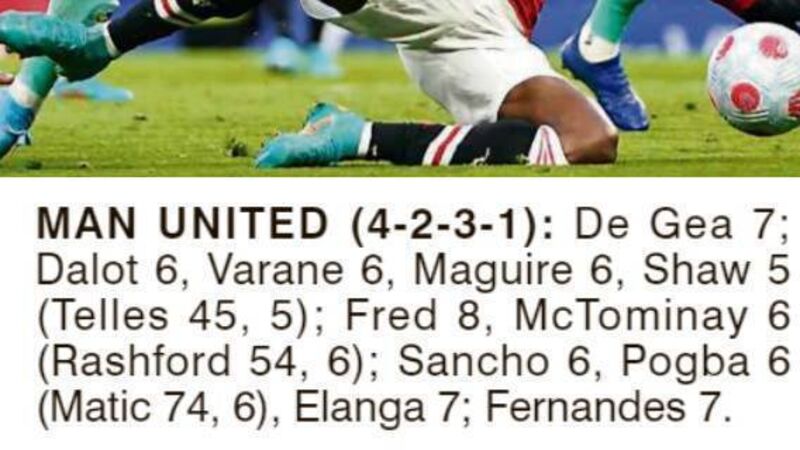CALL off the search, because we have finally reached a magic plane of revelation.
One of the banes of the existence of the poor benighted sports reporter is the player rating produced after games.
What are the criteria you use? Are they the same as mine? Is the scorer of a game’s crucial goal a 9 out of 10 by definition? What about the scorer of etc etc who also gave away the opposition’s most crucial score? What balances out the pluses and minuses?
What am I to give this fella I have never even noticed until now?
The participants’ fondness for checking their ratings is well known across all sports, though stoic acceptance of those ratings is often well hidden. Readers are often vocal enough on the subject, particularly when the original sin of player ratings is committed — when the total player ratings of the losing team is slightly higher than the total player ratings of the winning side.
(Not as implausible as it sounds, given that a number of the losers may have performed heroics and been outdone by a more balanced winning team . . . no? Just a theory of mine.) In any case the people responsible have spoken up and I feel cleansed.
“We put a scale in the paper each weekend,” Lionel Dangoumau, L’Equipe editor in chief of football explained to The Athletic recently.
“‘Ten-perfect, 9-exceptional, 8-very good, 7-good, 6-sufficient, 5-average, 4-insufficient 3-bad, 2-very bad, 1-catastrophic’. We hardly ever give a zero. It’s more for non-sporting behaviour — if someone threw a punch, for example.
“For a player to have a good rating, he really must have had a good game. We’re demanding with the players. If a player scores a goal, he’s not necessarily going to get an eight. It’s more complicated than that.
“Some consider that the level of the opponent is important. If you play a weaker opponent, you can’t have too high ratings, because it’s too easy.
“Others say that the mark should be based on the individual performance aside from the other parameters: was the match easy? Is he a big or average player?”
This is a whole level of detail that could spark a thousand further debates.
If the player is ‘big’, do they have a higher standard to reach in order to get a high mark than a journeyman who overachieves? Is it all dependent on the strength of the opponents anyway, or is that nonsense given the ability of the better team puts everything in context?
I’m not about to call Lionel’s bona fides into question but I can only surmise by his comments he’s not long in the job. My reasoning is simple enough — he says that usually a rating of zero is assigned to someone who throws a punch, etc., while it’s reasonable to presume that a 10, or perfect rating, is pretty rare.
However, the perverse luck of the sportswriter means that no sooner is such a scoring scheme introduced, or publicised, that the beams cross and the unthinkable happens: a player gets a championship-winning hat-trick and saves a child’s pet from drowning but also knocks out a match official, all in the one game.
What rating would be a fair reflection of that performance — zero or ten? Or perhaps 10 minus one with the rating buried under a cloud of asterisks?
I’m sorry to tell you, Lionel, but your comments mean you’ve jinxed yourself.
Sweden: Openness or boasting?
Heartiest congratulations to the Sweden women’s soccer team, who will play against Ireland tomorrow.
Not because they are playing Ireland, but because a few days back they unveiled a jersey that includes information and analysis designed to aid ... their opponents. How helpful it is remains to be seen.
An example? ”First of all, Sweden is one of the fastest-playing teams in the world and also one of the very best at counter-attacking, do everything you can to reclaim the ball once you lose it,” the jersey says.
“Try to force the Swedish players down the sidelines and close them down aggressively.”
It doesn’t end there. The Swedish Football Association has also released a digital guide, How To Stop Sweden, which is written by the team’s own head analyst, Anders Eriksson and which highlights 31 Swedish players in the team and gives specific advice on how opponents can best deal with them as they bid to stop Sweden this summer.
Because it’s Sweden I’m bound by years of practice to identify it as the country of origin of both Abba and Ikea, but for our purposes its reputation as an open and liberal democracy seems more germane.
Is this the ultimate expression of Scandinavian openness and tolerance, a manifestation of a deep desire for equality?
Or is it just the ultimate swagger, the last word in trailing your coat in front of the opposition?
Sometimes you can weary of hearing the constant trumpeting of the Scandinavian way(s) as the ultimate expression(s) in virtuous living, from their clean designs to their hygge to their progressive social policies.
It’s a bit of a jolt to be brought face to face with an attitude that suggests nothing more enlightened than ‘it ain’t boasting if you can do it’.
Which would have been a neater fit for the jerseys, come to think of it.
Emptying pockets for championship
The inter-county championships begin next weekend.
For this observer it means an annual ritual now takes place several weeks before it’s occurred in years past: namely, the packing of the backpack. Or maybe the unpacking of the superfluous.
Sometimes when you land into a press box someone next to you is carrying a superbly streamlined bag, accoutrements pared down to the minimum.
At the other end of the spectrum yours truly removed the following non-essential items from his backpack on Sunday to get ready for this year’s festivities.
A National Hurling League final match programme from 2006; a dozen batteries of all sizes; three notebooks half-filled with scrawls; 11 pens; a nine-foot cable that fits something or other; two CDs, the Hamilton soundtrack and the Best of KC and the Sunshine Band; a fistful of Scots Clan; three sets of earphones; and a Munster GAA car pass for a game in Mallow 10 years ago.
Next week: I investigate the front pocket. Wish me luck.
Causes of savagery
The Russian savagery in Ukraine has sent people looking for explanations in history books of all sorts, though neat sequences of cause and effect are hard to find.
A book I mentioned here last year might be an unlikely prospect: The Anthropocene Reviewed by John Green is a series of short essays on matters the author found interesting over the years, like the WWII siege of Leningrad which led to thousands of Russian starving to death.
A scientist who survived recalled later the agony of his next door neighbours, who lost their son to starvation and barely survived themselves before recovering sufficiently a few years later to have another son.
His name was Vladimir Putin.
Contact: michael.moynihan@examiner.ie









